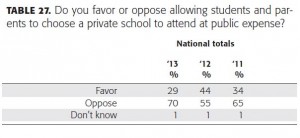 Perhaps not surprisingly, recent polls by two education organizations – one in support of, and the other skeptical of, school choice – report considerable differences in public opinion on school choice. The PDK/Gallup poll finds 70 percent of the public is opposed to vouchers while EducationNext finds only 37 percent of the public is opposed. While there’s always danger in reading too much into surveys produced by advocacy groups, the EducationNext methodology is cleaner and its finding therefore more likely to be on the mark.
Perhaps not surprisingly, recent polls by two education organizations – one in support of, and the other skeptical of, school choice – report considerable differences in public opinion on school choice. The PDK/Gallup poll finds 70 percent of the public is opposed to vouchers while EducationNext finds only 37 percent of the public is opposed. While there’s always danger in reading too much into surveys produced by advocacy groups, the EducationNext methodology is cleaner and its finding therefore more likely to be on the mark.
There are two main issues with the PDK/Gallup poll’s voucher question:
1) The voucher question response options are limited to “oppose” or “support” while many other questions allow responders to be “somewhat” supportive/opposed or “completely” supportive/opposed. Not allowing multiple levels of support, opposition or neutrality may be influencing responses.
2) The use of the word “expense” in the voucher poll question may negatively color responses. In fact, it’s not used ever again; not even for questions on potential new programs (Table 26 and 45).
The PDK/Gallup poll asks and finds:
The EducationNext Poll asks and finds:
According to the EducationNext poll, 44 percent of the public supports vouchers compared to only 29 percent in the PDK/Gallup Poll. It is worth noting that the PDK/Gallup poll doesn’t report the responses of various subgroups. For example, EducationNext finds a majority support for vouchers from parents, African-Americans and Hispanics.
You can see the wording of the question, and the allowable answers, are different between the two polls. EducationNext allows for margins of support or opposition and offers a neutral response to survey participants as well. The PDK/Gallup poll offers only a “support” or “oppose” response.
We see in the 2012 EducationNext poll that offering only “support” or “oppose” responses significantly alters answers. Opposition to low-income vouchers increased from 31 percent to 50 percent when responders were given only “support” or “oppose” as possible answers. The bulk of the formerly “neutral” responders shifted to “oppose.”
The 2013 EducationNext poll also found a shift from “neutral” to “oppose” simply by offering the “neutral” option at the end of the list of possible answers.
The absence of a ‘neutral’ and ‘somewhat’ levels support or opposition may be driving some of the results found in the PDK/Gallup poll.
Additionally, the phrasing the PDK/Gallup poll may also be coloring the responses. Although factually true, the phrase “at public expense” masks the fact that should the student attend a public school there would also be a “public expense” – and likely an even higher one.
The phrasing also implies that vouchers will be available for all students, including those already enrolled in private school. It is possible people don’t like the idea of providing financial support to students already attending private school. Again, the 2012 EducationNext poll already looked at the issue. They found opposition against a low-income voucher program fell from 45 percent to 31 percent by phrasing the question so the responder knew the voucher program would exclude students already enrolled in private schools.
Methodology matters and the phrasing of both the question and responses may be resulting in the PDK/Gallup poll overstating public opposition to school choice. Public support for school choice appears to remain steady and though there might be an increase in opposition, some of it is due to who is asking the question and how.





Gallop is an advocacy group? Also I am pretty sure people know the public pays for public schools.
Hi Chris,
No, I’m referring to PDK which Paul Peterson at Harvard (and EducationNext) considers an interest group as well. https://educationnext.org/can-education-polls-be-scientific-or-is-it-all-interest-group-politics/